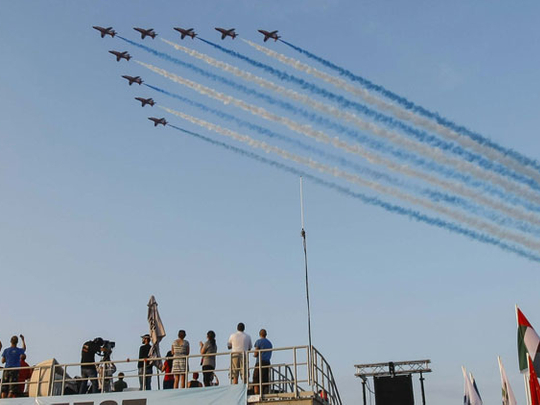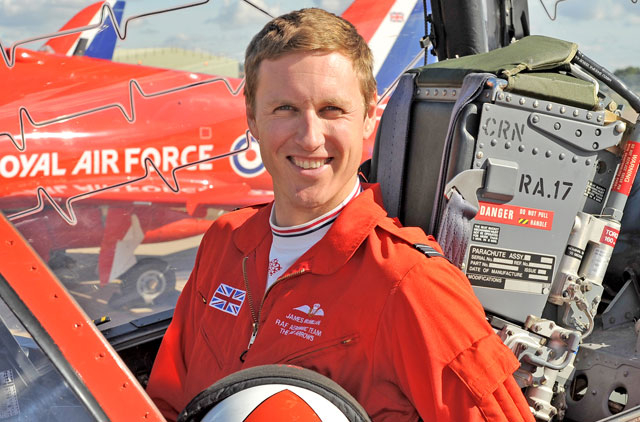
Dubai: It’s up there with the likes of spaceman or cowboy – one of the few things that can make a starry eyed child sit up and say: “I want to do that when I grow up.”
So how do you go from childhood dreams to sitting in the cockpit of a Red Arrows jet? Ask Flight Lieutenant James McMillan, who, aged 9, saw his future while watching in awe as the brilliant red jets cut across blue sky at speeds reaching Mach 1.2.
After performing at air shows in Dubai and Al Ain, the Red Arrows will fly to Jordan to end a Middle East tour which included performances in Abu Dhabi, Kuwait, Oman, Qatar and Saudi Arabia.
Now 31, Flt Lt McMillan, otherwise known as Red 7, is two years into his three-year tour as a pilot in the world’s most famous aerobatic team.
“It’s one of those jobs that as a little kid you view it as something that would be amazing, almost unobtainable,” said the New Zealand-raised Brit, who was the youngest qualified fast jet pilot in the Royal New Zealand Air Force.
“I first saw the Red Arrows at Farnborough [in the UK] when I was nine-years-old and I was just blown away. Already at that stage, I wanted to be a fast jet pilot, and that is the only route to becoming a Red Arrow.
“But I didn’t join the RAF because I wanted to be in the Red Arrows, I joined because I wanted to fly fast jets, and to be honest I forgot about the Red Arrows, certainly for the first part of my career. It’s only when you’ve been in the RAF for eight to 10 years that it suddenly becomes a potential reality.
“It only really sinks in once you are in there that the guys you idolised as a nine-year-old at Farnborough Air Show, you are now in the suit.”
So what does it take to be in control of one of the nine Hawk T1s given pride-of-place at the planet’s biggest air shows? You might think pilots must be fearless thrill-seekers with nerves of steel to perform the gravity defying routines within metres of another jet.
Not so, according to Flt Lt McMillan, who puts it all down to proper preparation.
“I don’t think it’s got anything to do with being brave or fearless,” he admitted. “It’s all about being very professional and training an awful lot. We have done it hundreds of times already, so it doesn’t really raise the heartbeat anymore.
“You trust the equipment and each other. It really is about flying three times a day, five days a week, and learning how each other work, which enables you to fly 6ft [1.8 metres] away from four other aeroplanes.
“I get to do one of the more interesting jobs, the opposition passes that the Red Arrows are famous for – the bits where it looks like we are going to hit each other but we don’t. It still gives me a thrill. I think it’s the best job in the world, I still have to pinch myself sometimes. Some days it’s easy to lose sight of that most people would kill to be where you are, but that grounds you.
“What we really like to do is come to air shows like in Al Ain and meet the public and get the one-on-one reaction. Seeing how much people enjoy the show tends to give you a kick rather than the flying itself.
“It’s only three years in the Red Arrows, which is the standard length of a military tour, and then you merge back into the normal Air Force. I thing on of the hardest things about joining the team is going to be leaving. Everyone misses it immensely.”
Flt Lt McMillan says winter weather in this part of the world is perfect for the team’s precision formations and dynamic loops and rolls – most of the time.
“It has been absolutely amazing,” he said. “We have been so well-received. It has been really humbling.
“The main reason we came here was to perform at the Dubai Airshow and wave the British flag. We also displayed at the Abu Dhabi corniche. We are used to displaying over flat sites like an airfield or a coastal site by a beach, so having 200ft buildings right behind the display site gives us something else to think about. You are not used to seeing things so big and close – albeit very quick glances.
“Heat doesn’t cause us much of a problem. The aeroplanes they fly slightly differently, the engines have a slightly difference performance level, but we do a lot of training in Cyprus, where the weather is very similar, so we are used to it. What we really enjoy about here is getting up there without a cloud in the sky and doing our best show every day.
“One day in Dubai, we didn’t get to perform because the winds kicked up a lot of dust and visibility dropped right down, and then the last day of the Airshow, an unusual weather pattern brought lots of thunderstorms.
“It was a real shame because, as a UK team, we can display down to some poor weather conditions. However, the conditions in Dubai those days were beyond that.
“Dubai was a very commercial show whereas Al Ain was much more flying-orientated. It was all about trying to impress the public as much as possible. It’s probably more geared to what we are about because, really, we are professional show-offs.”












